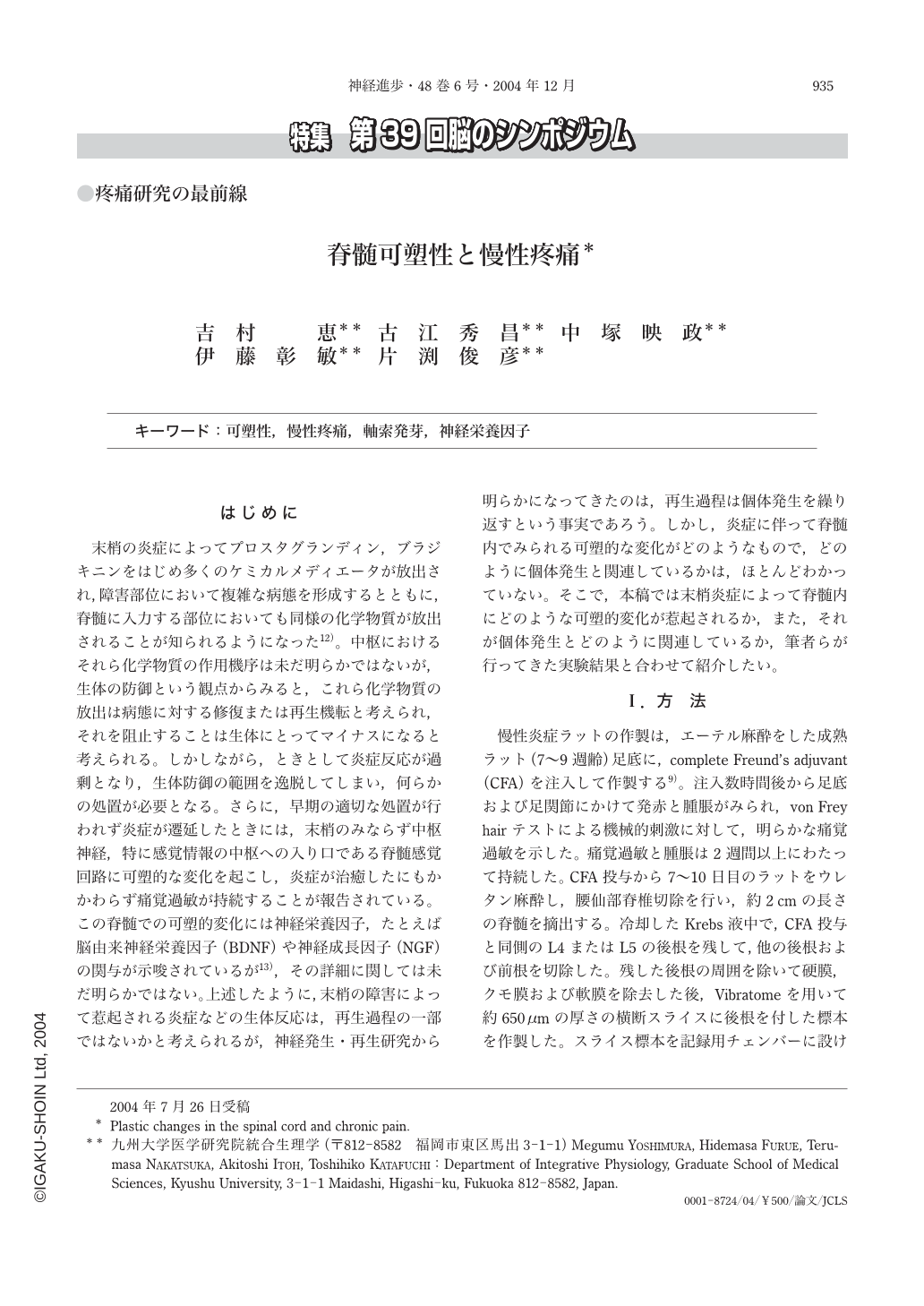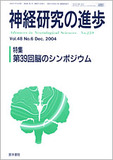Japanese
English
- 有料閲覧
- Abstract 文献概要
- 1ページ目 Look Inside
はじめに
末梢の炎症によってプロスタグランディン,ブラジキニンをはじめ多くのケミカルメディエータが放出され,障害部位において複雑な病態を形成するとともに,脊髄に入力する部位においても同様の化学物質が放出されることが知られるようになった12)。中枢におけるそれら化学物質の作用機序は未だ明らかではないが,生体の防御という観点からみると,これら化学物質の放出は病態に対する修復または再生機転と考えられ,それを阻止することは生体にとってマイナスになると考えられる。しかしながら,ときとして炎症反応が過剰となり,生体防御の範囲を逸脱してしまい,何らかの処置が必要となる。さらに,早期の適切な処置が行われず炎症が遷延したときには,末梢のみならず中枢神経,特に感覚情報の中枢への入り口である脊髄感覚回路に可塑的な変化を起こし,炎症が治癒したにもかかわらず痛覚過敏が持続することが報告されている。この脊髄での可塑的変化には神経栄養因子,たとえば脳由来神経栄養因子(BDNF)や神経成長因子(NGF)の関与が示唆されているが13),その詳細に関しては未だ明らかではない。上述したように,末梢の障害によって惹起される炎症などの生体反応は,再生過程の一部ではないかと考えられるが,神経発生・再生研究から明らかになってきたのは,再生過程は個体発生を繰り返すという事実であろう。しかし,炎症に伴って脊髄内でみられる可塑的な変化がどのようなもので,どのように個体発生と関連しているかは,ほとんどわかっていない。そこで,本稿では末梢炎症によって脊髄内にどのような可塑的変化が惹起されるか,また,それが個体発生とどのように関連しているか,筆者らが行ってきた実験結果と合わせて紹介したい。
Mechanisms for chronic pain induced by peripheral injury or inflammation have been extensively explored, and demonstrated that those are not only due to sensory receptor sensitizations but also due to plastic changes in the central nervous system. Following inflammation, several chemical mediators, including prostaglandin, and neurotrophic factor such as BDNF are released in the spinal cord which are thought to play an critical role in the induction of plasticity. In the present study, we investigated a plastic change following inflammation in the spinal dorsal horn by means of in vitro and in vivo patch-clamp recordings from substantia gelatinosa(SG, laminaⅡof Rexed)neurons. In normal condition, SG neurons received inputs preferentially from Aδafferents and/or C afferent fibers and Aβafferent inputs were detected in only 2%of neurons. On the other hand, in the early phase of inflammation(2 to 3 days after inflammation), substantial number of SG neurons received polysynaptic inputs from Aβafferents which originally terminated at the deep dorsal horn, and subsequently those afferents sprouted into SG and made monosynaptic contacts with SG neurons 5 to 7 days after inflammation. It is conceivable that the plastic changes in the sensory circuitry observed in the inflamed rats were a part of regeneration processes. Therefore, we next tested whether the circuitry following inflammation had a similarity with that of the neonatal rat spinal cord. Monosynaptic inputs from primary afferent to SG neurons in neonatal rats spinal cord(3 week old)were largely from Aβafferents and a small population of neurons had monosynaptic inputs from Aδafferents. Direct inputs from C afferents were detected in a few neurons. Thus, the synaptic circuitry in the neonatal rat spinal cord is similar to those of inflamed rats, with the exception of low incidence of C afferent inputs. These observations suggest that the sprouting of Aβafferents to SG neurons is a part of the regenerative process. However, the processes observed in the inflamed rats would not be exactly the same as those of development, such different might be the underlying mechanisms for hyperalgesia in inflamed condition. Therefore, clarification of the differences between the processes of development and reorganization of the synaptic circuitry following the inflammation should be the one of essential steps for understanding the pathological pain and might provide a therapeutic target.

Copyright © 2004, Igaku-Shoin Ltd. All rights reserved.


